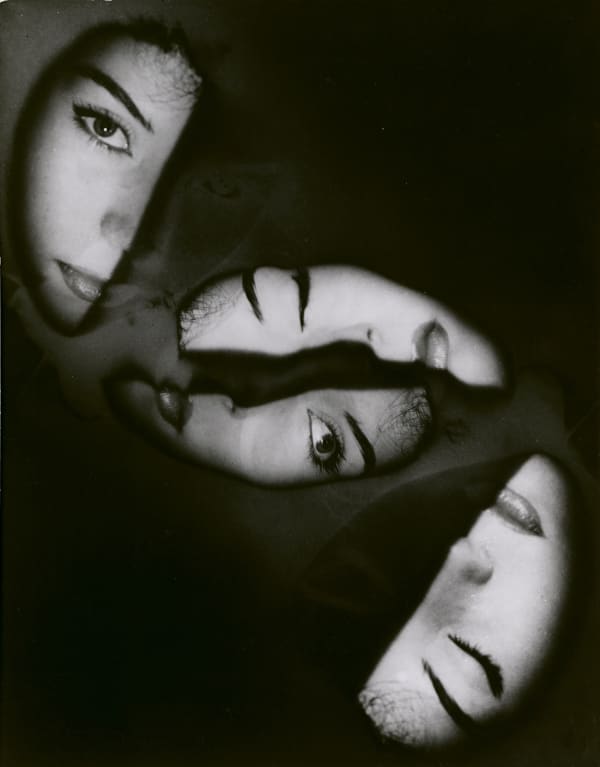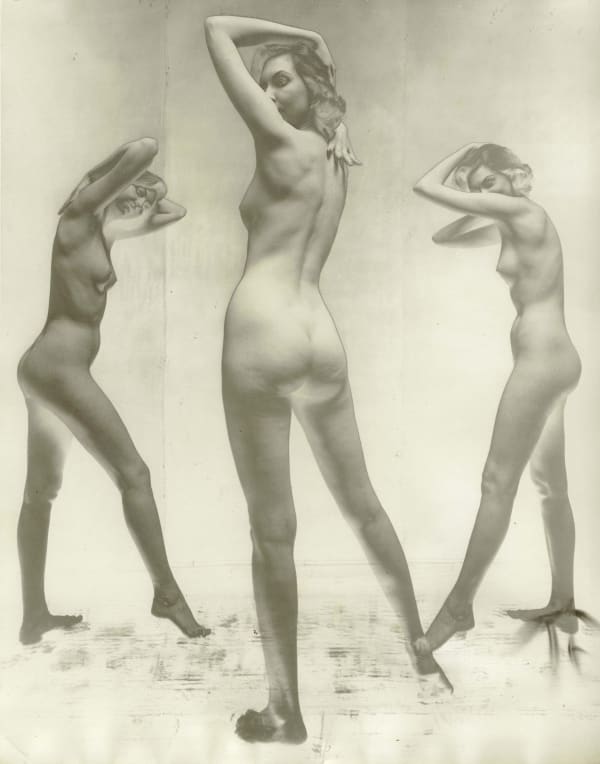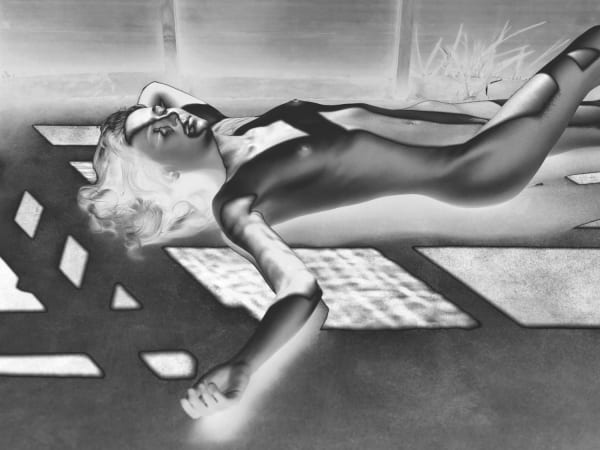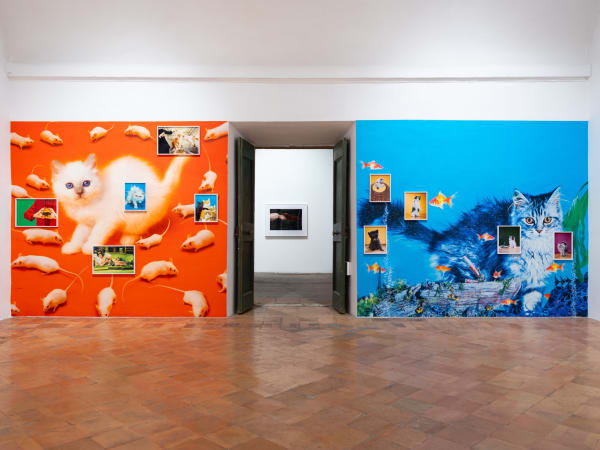Erwin Blumenfeld
Erwin Blumenfeld is considered to be one of the early pioneers of fashion photography alongside George Hoyningen-Heune, Cecil Beaton, and Horst P. Horst. It was not only his employment of experimental techniques in the darkroom, Dada and Surrealist influences, and groundbreaking street work, but Blumenfeld's unique and masterful combination of elegance and eroticism that transformed fashion into high art and paved the way for Richard Avedon, Irving Penn, Herb Ritts, and other photographers who enjoyed such prominence and recognition in the history of art.
In addition to holding the record for the most covers of Vogue, Blumenfeld's works were abundantly reproduced within the pages of Cosmopolitan, Harper's Bazaar, Life and Vogue during the 1930s, '40s and '50s. Many of the images from these shoots will be featured in this exhibition and have since become icons of the history of fashion photography. Some have never been seen before. But all of the prints showcase not only Blumenfeld's innovation as a photographer of fashion but also his spectacular skill as a printmaker. In his retrospective examination of Blumenfeld's work, William Ewing writes, "His highly original and visionary work was a seamless blend of the negative and positive: taking the picture in the studio and making it in the darkroom."
In the studio, Blumenfeld often employed mirrors, glass, and backgrounds reproduced from paintings, images of cathedrals, or mosaics of magazine covers. He often used veils, which could distort or elongate the figure, confident that a woman partially concealed was more erotically charged that one seen fully nude. He also believed the printing of the image was as every bit as important as the process of capturing it, and like Man Ray, he was tirelessly inventive in the darkroom, deploying a variety of optical and chemical tricks, including multiple exposures, solarization and bleaching.
Blumenfeld was born in Berlin in 1897, and as a young man he moved to Amsterdam. It was there, while keeping a leather goods shop, that he began to experiment with photography and became involved with the Dada movement. He would use the shop's storeroom as his darkroom, and would display his photographs in the windows. Success in the leather business eluded him, but his confidence with photography grew, and when he relocated to Paris in 1936, he set out on the career that was to make him famous. While initially the fashion magazines were reluctant to employ him, the more avant-garde publications like Photographie regularly featured his work. Finally, with the crucial support of the British photographer Cecil Beaton, who was closely affiliated with Condé Nast, Blumenfeld was awarded a contract with Vogue in 1938. In the summer of 1941, just after his release from an internment camp during the German occupation of France, Blumenfeld and his family emigrated to New York. By the 1950s, he was the most accomplished and highest paid fashion photographer in the world.
-
 Erwin Blumenfeld"Blurred sitting nude", n.d.
Erwin Blumenfeld"Blurred sitting nude", n.d. -
 Erwin BlumenfeldDayton's Oval Room, Minneapolis, 1956
Erwin BlumenfeldDayton's Oval Room, Minneapolis, 1956 -
 Erwin BlumenfeldDiane de Houdon, New York, 1943
Erwin BlumenfeldDiane de Houdon, New York, 1943 -
 Erwin BlumenfeldDoe Eye, Jean Patchett, Vogue, New York, 1 January 1950
Erwin BlumenfeldDoe Eye, Jean Patchett, Vogue, New York, 1 January 1950 -
 Erwin BlumenfeldHenri Matisse, Paris, 1937
Erwin BlumenfeldHenri Matisse, Paris, 1937 -
 Erwin BlumenfeldLa Pudeur, Paris, 1937
Erwin BlumenfeldLa Pudeur, Paris, 1937 -
 Erwin BlumenfeldMarua Motherwell, New York, c. 1941
Erwin BlumenfeldMarua Motherwell, New York, c. 1941 -
 Erwin BlumenfeldNude torso, n.d.
Erwin BlumenfeldNude torso, n.d. -
 Erwin BlumenfeldPortrait study, c. 1930s
Erwin BlumenfeldPortrait study, c. 1930s -
 Erwin BlumenfeldRouen La Flèche (View from the Tower of Rouen Cathedral), 1938
Erwin BlumenfeldRouen La Flèche (View from the Tower of Rouen Cathedral), 1938 -
 Erwin BlumenfeldUntitled, c. 1940's
Erwin BlumenfeldUntitled, c. 1940's -
 Erwin BlumenfeldUntitled beauty photograph showing make-up and coiffure, New York, 1949
Erwin BlumenfeldUntitled beauty photograph showing make-up and coiffure, New York, 1949 -
 Erwin BlumenfeldUntitled nude, n.d.
Erwin BlumenfeldUntitled nude, n.d. -
 Erwin BlumenfeldUntitled Nude, New York, c. 1952
Erwin BlumenfeldUntitled Nude, New York, c. 1952 -
 Erwin BlumenfeldWet Veil, c. 1937
Erwin BlumenfeldWet Veil, c. 1937
-

Mona Kuhn: Between Modernism and Surrealism
4 April - 25 May 2024Edwynn Houk Gallery presents “Mona Kuhn: Between Modernism and Surrealism,” an exhibition of 7 solarized photographs by Mona Kuhn from her series Kings Road in dialogue with artworks by masters exploring surreal representation, including Man Ray, Láslzó Moholy-Nagy, Dora Maar, Erwin Blumenfeld, and Bill Brandt from April-May 2024.Read more -

Erwin Blumenfeld
5 April - 30 June 2018Read more -

The Modern Eye: Photographs 1917 - 1939
9 April - 16 May 2015Read more
-

Chromotherapia: Feel-Good Color Photography at Villa Medici
Work by Erwin Blumenfeld included 28 February 2025February 28–June 9, 2025 | Villa Medici - Académie de France à Rome Chromotherapia, cocurated by Maurizio Cattelan and Sam Stourdzé, invites the viewer to...Read more -

Beauty and Style: The History of Fashion Photography
Erwin Blumenfeld at The Hermitage Museum, St. Petersburg 12 December 2021Beauty and Style. The History of Fashion Photography from the Collection of the Still Art Foundation opened 12 December at the State Hermitage Museum in...Read more -

Unseen: 35 Years of Collecting Photographs at the Getty Museum
Featuring work by Abelardo Morell, Mona Kuhn, Valérie Belin, & more 17 December 2019The Getty Museum's curatorial team has unearthed an array of treasures that have never been shown here before.Read more -

Erwin Blumenfeld at Edwynn Houk
Erwin Blumenfeld in Collector Daily 24 May 2018Erwin Blumenfeld had a full retrospective at the Jeu de Paume in Paris in 2013, so the arc of his photographic career, and its movements...Read more -

Les photographes de Vogue à Paris Photo 2016
Erwin Blumenfeld in Vogue 10 November 2016De l’érotisme chic de Peter Lindbergh au classicisme bourgeois d’Horst P.Horst en passant par les amazones d’Herb Ritts, les légendes de la photographie d'hier et d'aujourd'hui, complices d'un jour ou de toujours de Vogue, sont aujourd’hui exposées à Paris Photo. Sélection.Read more























